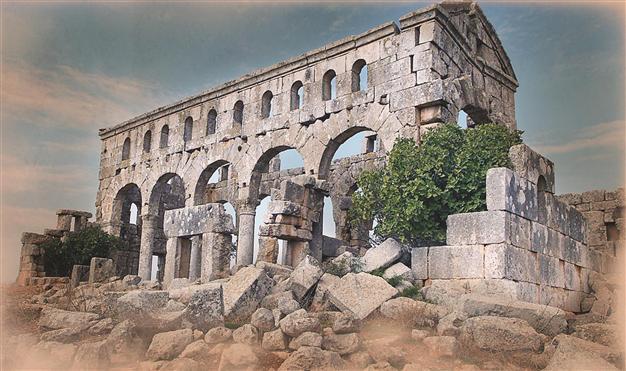Wars destroy thread of common history
ANKARA - Anatolia News Agency

As an ancient trading center, Aleppo’s impressive souks, khans, hammams, madrasas, mosques and churches are all in need of more care and preservation work. Between 1954 and 1983 many buildings in the old city were demolished.
Civil Wars in Iraq, Mali, Syria, and Afghanistan and various other places in the world damage cultural artifacts a great deal. Presently, Syria has seen more than its share of bad days and war threatens the common history of human beings that have lived and still live in the region. Cultural and historical artifacts from various nations currently located in Syria are under threat due to land and air attacks.Support for agreements protecting a country’s cultural and historical heritage are important, the head of UNESCO Turkey’s National Commission Professor Dr. Öcal Oğuz said, speaking to Anatolia news agency. “Known as Syria’s The Hague Agreement, or the Protection of Cultural Heritage in Case of Armed Conflict Agreement, was signed in 1954. Some other agreements were signed for the protection of historical artifacts,” Oğuz said, adding the he fully supports those agreements.
“According to Syria’s [UNESCO] agreement, signed in 1972, there are six cultural heritages on the World Heritage List, including the cities of Damascus, Basra and Aleppo and Saladin Castle,” Oğuz said.
The agreements with UNESCO gave Syria the responsibility to protect the cultural heritage of the locations and pass them on to the country’s future generations. “UNESCO requires protecting the historical artifacts in case of armed conflict from countries accepting the agreement in 1954. Political Agents and parties should be more sensitive in that sense,” Oğuz said.
Syria’s History might disappear
According to Oğuz everyone is responsible to protect their own city’s cultural heritage. “It is also very important to pass the cultural and historical heritages down to future generations in order to keep awareness of the city’s heritage alive,” he said.
“In the countries that are experiencing civil wars, both humans and human artifacts are destroyed. Many valuable historical artifacts were stolen in Iraq when museums were destroyed,” Oğuz said.
Conflicts in Mali and Afghanistan have also led to numerous artifacts suffering damage, Oğuz said. “Now we experience the same situation in Syria. There are many mosques, castles, bridges, baths, caravanserais, schools and fountains in Syria, which was once was under the reign of the Ottoman Empire.”
The most renowned artifacts in Syria are Roman remnants, the Knight Castle, Dera, Lazkiye, Hummus and Aleppo, all of which are in danger, according to Oğuz. “If no one takes them under protection, they might disappear,” he said.
Authorities to tackle the problem
UNESCO Turkey’s National Commission plans to convey the issue of heritage protection to authorities to bring awareness to the problem. “We, as UNESCO, hope that our neighbor Syria’s conflict ends as soon as possible. And we hope the necessary measures are taken in order to protect the cultural heritages,” he said.
“It does not fall into our authority to task the situation and protection of the artifacts in Syria, he said.
“But we can’t help but think about [ensuring] the artifacts pass down to future generations without damage. It is a general approach of UNESCO,” said Oğuz.
About Aleppo’s ancient heritages
As an ancient trading center, Aleppo’s impressive souks, khans, hammams, madrasahs, mosques and churches are all in need of more care and preservation work. Between 1954 and 1983 many buildings in the old city were demolished to allow for the construction of modern apartment blocks, particularly in the northwestern areas such as Bab al-Faraj and Bab al-Jinan. As awareness for the need to preserve this unique cultural heritage increased, Gutton’s master plan was finally abandoned in 1979 and replaced with a new plan presented by the Swiss expert and urban designer Stefano Bianca, which adopted the idea of “preserving the traditional architectural style of Ancient Aleppo” paving the way for UNESCO to declare the Old City of Aleppo a World Heritage Site in 1986.
Several international institutions have joined efforts with local authorities and the Aleppo Archeological Society to rehabilitate the old city by accommodating contemporary life while preserving the old one. The governorate and the municipality are implementing serious programs directed toward the enhancement of the ancient city and the Jeddah quarter.
















